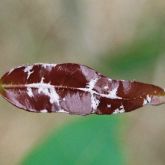Quambalaria shoot blight

White spore masses along the leaf veins of a spotted gum leaf, caused by Quambalaria shoot blight
© Queensland Government

Quambalaria shoot blight on a spotted gum shoot, showing white fruiting structures and distorted leaves
© Queensland Government

Twists and curls of new shoots and leaves, caused by Quambalaria shoot blight
© Queensland Government

Quambalaria shoot blight on a growing tip of a spotted gum seedling
© Queensland Government

Dieback of a growing tip, caused by Quambalaria shoot blight
© Queensland Government
Quambalaria shoot blight is a disease caused by infection from the fungus Quambalaria pitereka. It damages new shoots and leaves, affecting growth and form in spotted gums (Corymbia species). The disease causes most damage in wetter conditions.
Spotted gum species and provenances (origins) differ in their susceptibility to the fungus.
Scientific name
Other names
- Formerly Ramularia pitereka and Sporothrix pitereka
- Smut fungus
Similar species
Quambalaria leaf spot (Quambalaria eucalypti) causes small, irregular lesions on juvenile foliage and stems and can be associated with insect feeding damage. When present, white pustules are usually on the lower leaf surfaces. In Queensland and New South Wales, Quambalaria leaf spot has been found on Eucalyptus dunnii, E. globulus, E. grandis, E. longirostrata and E. microcorys, but it is not considered to cause severe shoot or stem blight.
- Q. cyanescens has been recorded on some Corymbia species in Queensland and New South Wales. It causes discrete elliptical lesions and white or pink spore masses on woody stems and branches. This species does not appear to be widespread in Queensland or to cause severe damage.
- Q. coyrecup has been recorded in Western Australia and the Northern Territory. It causes stem cankers on Corymbia species and is associated with severe dieback of trees in Western Australia.
Description
- Occurs on the upper and lower leaf surfaces of new flushes of foliage, on flowers, on fruit and on juvenile stems.
- Tiny white pustules first appear on immature foliage, especially at leaf edges, along the leaf veins and where the leaf stalk joins the leaf blade.
- Within a few days chlorotic spots with necrotic centres are visible on leaves.
- White, shiny or powdery fungal spore masses develop on leaves and young stems.
- Leaves and stems become curled or twisted.
Distribution
- Queensland and northern New South Wales
- Western Australia (believed to have been introduced), impacting native marri (Corymbia calophylla)
Hosts
- Spotted gum (Corymbia citriodora subspecies variegata)
- Lemon-scented gum (C. citriodora subspecies citriodora)
- Spotted gum (C. maculata)
- Large-leaved spotted gum (C. henryi)
- Cadaghi (C. torelliana) – less common
- Corymbia hybrids – less common
- Moreton bay ash (C. tessellaris)
- Angophora costata, and less commonly other Angophora species
- Eucalyptus grandis, E. nitens, E. globulus and E. saligna hybrids (overseas)
Damage
- Leaf spots and death in new flushes of foliage
- Gross distortion of expanding leaves and curled or twisted young stems
- Distortion and dieback of growing tips and upper side branches
- Negative effects on stem form, growth rates and timber quality
- From repeated infection, stunted, bushy trees, or tree death in severe cases
- Severe damage in young spotted gum plantations (up to 3 years old)
- Foliage blight and stem cankers on mature spotted gum trees in native forests
- Variable damage within plantations, species and provenances
Biology
- Spread and infection occurs optimally at high humidity levels or in the presence of water, at temperatures from 15 to 30 degrees Celsius.
- Spores adhere to the leaf and stem surface, and penetration by hyphae occurs through stomata and wounds.
- The first symptoms of Quambalaria shoot blight appear about 5 days after infection, and consist of tiny white pustules on leaves and stems.
- Sporulation of Q. pitereka and Q. eucalypti can occur 7 to 10 days after inoculation of susceptible host plants under optimal conditions.
Control
- Avoid infection in the first years of a new plantation by using healthy stock plants. These could be sprayed with fungicide prior to planting.
- Establish new spotted gum plantations well away from native stands and existing plantings of other Corymbia species, particularly if they are young or showing signs of Quambalaria shoot blight.
- Control in plantations using fungicides is unlikely to be effective unless done frequently to ensure all new flushes of foliage are protected. Also, there are no chemicals registered for this purpose in plantations at present.
- Some provenances of spotted gum (Corymbia citriodora subspecies variegata, such as Woondum provenance) appear to have more tolerance to Quambalaria shoot blight. However, variability in the pathogen population needs to be considered and may influence host susceptibility levels.
- Breeding for resistance is a longer term management option.
Resources and research
- Carnegie, A, Lawson, SA, Smith, T, Pegg, GS, Stone, C, McDonald, J, 2008, Healthy hardwoods: a field guide to pests, diseases and nutritional disorders in subtropical hardwoods, Forest and Wood Products Australia, Victoria
- Lee, DJ, Huth, JR, Brawner, JT, Dickenson, GR, 2009, Comparative performance of Corymbia hybrids and parental species in subtropical Queensland and implications for breeding and deployment, Silvae Genetica, 58(5/6):205–212
- Pegg, GS, Carnegie, AJ, Wingfield, MJ, Drenth, A, 2009, Quambalaria species: increasing threat to eucalypt plantations in Australia, Southern Forests: A Journal of Forest Science, 71(2):111–114, viewed Aug 2023
- Pegg, GS, O'Dwyer, C, Carnegie, AJ, Burgess, TI, Wingfield, MJ, Drenth, A, 2008, Quambalaria species associated with plantation and native eucalypts in Australia, Plant Pathology, 57:702–714, viewed Aug 2023
- Pegg, GS, Webb, RI, Carnegie, AJ, Wingfield, MJ, Drenth, A, 2009, Infection and disease development of Quambalaria spp. on Corymbia and Eucalyptus species, Plant Pathology, 58:642–654, viewed Aug 2023